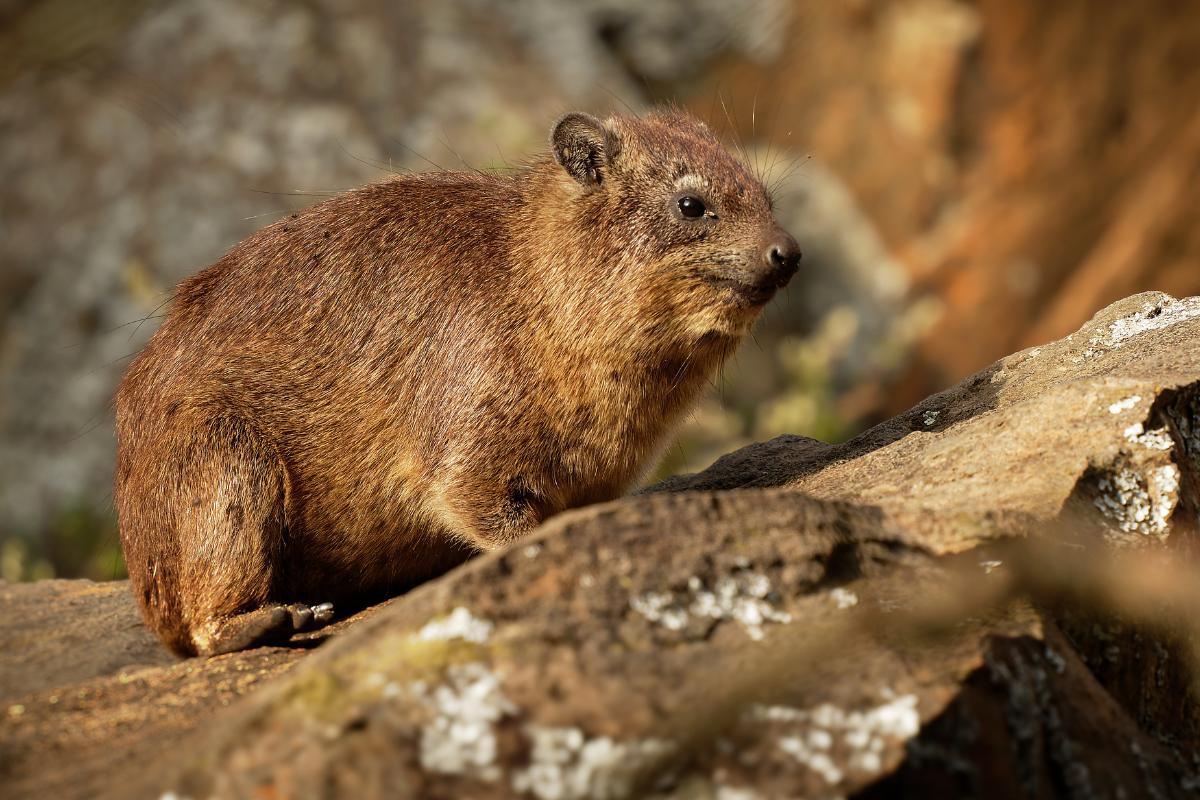What Is a Hyrax Animal?

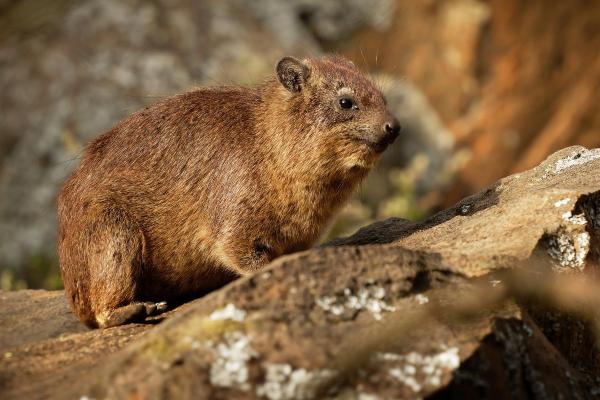
The hyrax is a small mammal that may look like a rodent, but is more similar to an elephant in terms of evolution and taxonomy. It most commonly lives in Africa, but does have some some populations in the Middle East. It averages up to 15 years in the wild, being good at surviving in a variety of habitats. This is thanks to some unique evolutionary traits, including a multi-chambered stomach and specially adapted teeth. They are the only animal within the order Hyracoidea, but there are various genera and individual species which this order encompasses. thedailyECO explains more about their habitat, diet and reproduction as we ask what is a hyrax animal?
What is a hyrax?
A hyrax is a type of small mammal that lives in the order Hyracoidea. While they share some physical and behavioral characteristics with certain rodent species, they are actually from the clade Paenungulata. This clade also includes much larger mammals such as elephants and sea cows. To better understand what is a hyrax animal, we can look more closely at their characteristics:
- Hyraxes are characterized by having a pair of fangs protruding from their mouths, which are actually the very elongated front incisors. Like rodents, these incisors grow continuously throughout their lives and must be worn down to prevent dental problems.
- The body is compact, with a short neck and snout. It measures between 12 and 24" (30 and 60 cm) in length.
- They have small rounded ears and large eyes positioned towards the front.
- Despite being mammals, they don't have a very good thermoregulatory capacity to keep their bodies warm, so they resort to lying in the sun to ensure their metabolism functions properly.
- They have a sticky substance on the soles of their feet that helps them cool off from the heat. This helps some hyrax species climb trees or rocks.
- They are classified as penungulates, which means they are almost ungulate mammals. An ungulate is characterized by walking on the tips of its toes, which are covered by hooves. This is seen in the fact elephants walk on their toes, but goats do not. Elephants are plantigrade animals and hoof-like nails on each individual toe. Hyraxes have rubbery pads on their feet which also contain sweat glands, unlike the rest of their body.
- Proboscideans are the order which contains elephants and to which hyraxes have certain similarities. These include the fact their testes are located near the kidneys and that they have auxiliary nipples. The most obvious is the tusk-like incisors which are seen as being similar to elephant tusks.
- In addition to hyrax, these mammals are known as dassies or hyracoids (the latter referring to their order Hyracoidea).
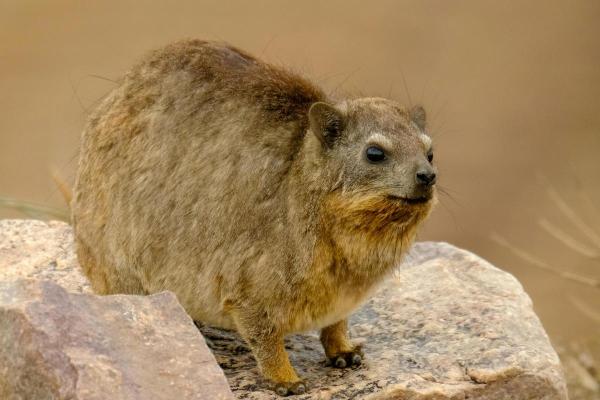
Where do hyraxes live?
Currently, there are only three genera of hyraxes, which differ in terms of their preferred habitat. They are:
- Rock hyrax (Procavia spp.): lives on boulders and rocks. It is the largest and also the most common.
- Tree hyrax (Dendrohyrax spp.): are characterized by living in trees, where they lodge in nooks or holes that form inside the trees which are mainly dry.
- Bush hyrax (Heterohyrax brucei): also known as the yellow-spotted rock hyrax, they are the only member of their genus and are slightly smaller than the rock hyrax in Procavia.
As for their geographical location, hyraxes are Afrotherians. This means we can mainly find them in Africa, although they can also be found in some small areas of the Middle East.
Hyrax diet
Hyraxes are herbivorous animals. They primarily seek out plant leaves, although they also eat fruits, twigs and tender shoots. They may also supplement their diet with tree bark.
To process the high amount of lignin present in plant matter, hyraxes have a multi-chambered stomach where food is processed to the maximum. Despite this, they are not types of ruminant animals such as cattle which also have multi-chambered stomachs. They also have a high-functioning microbiota that helps them break down food.
The dentition of hyraxes has strong, crested molars similar to those of rhinoceroses. While their incisors are sharp and long, they are not used for breaking down plant material. They use their molars to do so instead, resulting in them tearing at plant material with the sides of their mouth rather than the front.
Learn about other types of animals that feed on plants with our guide to the different types of herbivorous birds.
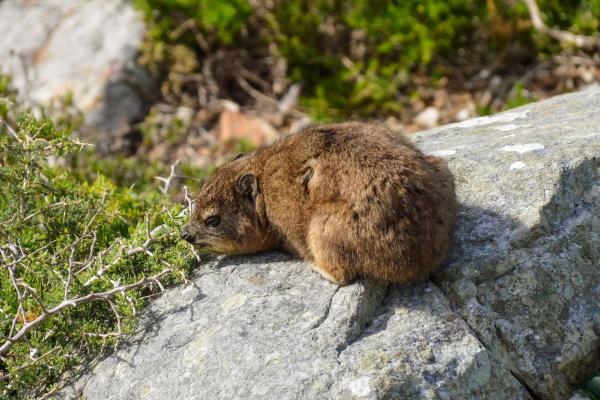
Behavior of the hyrax
We have explained a little about the physical characteristics, diet and habitat of the hyrax. We now look at their behaviors when interacting with their respective habitats:
- They are very vocal, but the nature of their vocalizations can change drastically. For example, some are known for their squeak and others their bark, although all can make a range of vocalizations.
- They are gregarious and live in groups of almost 100 individuals. Learn about another gregarious mammal with our article sharing fun facts about capybaras.
- They are shy around others who are not of their own species.
- There are both diurnal and nocturnal hyraxes, depending on the species.
You can learn about other animals which are most active during the day with our article on the largest eagles in the world.
Hyrax reproduction
Hyraxes are viviparous mammals, means the female develops the embryo of their offspring internally after fertilization. They have a very peculiar characteristic in that females have a double uterus, also known as a duplex uterus. This is a typical characteristic of primitive mammals where the uterus has two uterine horns. This is one reason why gestation is very long, lasting around 7 months.
The result of hyrax gestation results in an average of 3 young, with a maximum of 8 young in the litter. Hyrax are born precocial, meaning they are born relatively well developed. While they will still need their mother for feeding, their eyes are open at birth and can have good mobility within hours.
To learn more about the reproductive habits of other relatively rare mammals, you may want to check out our article asking is the platypus a mammal or a bird?

Are hyraxes endangered?
Hyraxes are not in danger of extinction, although they do face certain threats. Perhaps the most pressing is habitat loss which fragments communities, preventing them from reproducing and increasing genetic variability. This habitat loss also affects the places they can inhabit and the amount of food available to them.
Conservation of the world's mammals is a difficult task and requires a multifaceted approach, something about which you can learn more with our article asking why are giant armadillos endangered?
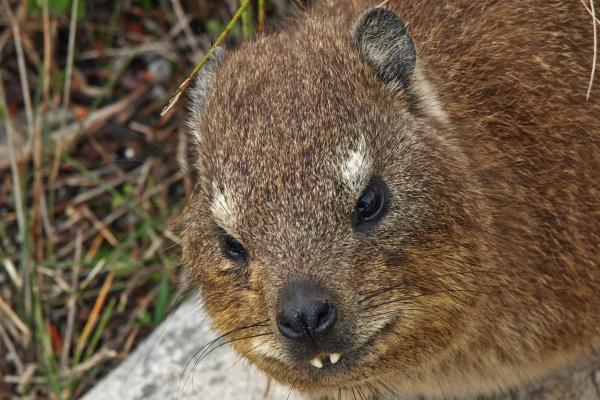
Fun facts about hyraxes
Finally, we finish by sharing some fun hyrax facts:
- Being a distinct group, hyraxes have many distinctive characteristics. They have the body of a guinea pig, the incisors of a bat, the back teeth of a rhinoceros, the body temperature of a reptile and the stomach of a cow.
- The life expectancy of the hyrax is relatively long, living an average pf between 10 and 15 years.
- A theory about the origins of the name for Spain is related to this mammal. It claims that, when the Phoenicians were on their way to Spain, they saw hyraxes in Africa. When they ventured further to Spain and saw their abundance of hares, this mistook the lagomorphs for hyraxes and called the land I-shaphan-im, meaning ‘land of rock rabbits (hyraxes)’. This is only one theory about the origins of the name of the country and cannot be historically verified.
- They have a very long nail that they use to scratch themselves.
We provide more background information about animals like the hyrax with our article on the different types of mammals.
If you want to read similar articles to What Is a Hyrax Animal?, we recommend you visit our Wild animals category.
- Padilla Álvarez, F., & Cuesta López, A. E. (2003). Applied zoology. Colombia: Díaz de Santos.





